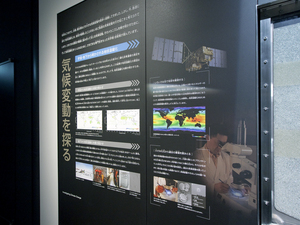Nagoya City Science Museum
TOP > Exhibition Guide > Keyword Search > Starting with "C" > Climate Change > Investigating Climate Change
Investigating Climate Change



Purpose of Exhibition
The mechanisms of climate change are being investigated because global warming is a prevalent issue today. By using research on space, underground and information technology, scientists and engineers are pioneering our future.
Additional Knowledge
[The Complicated Mechanism of Climate Change]
Constant weather observation by scientists revealed that the average temperature of the earth has risen 0.7 degrees celcius over the past century. As you know, the widely accepted hypothesis that explains the cause of climate change is the increase of greenhouse gas emissions (especially carbon dioxide) as a result of human activity.
However, it is difficult to prove this hypothesis, because there are so many possible factors to explain climate change, such as solar radiations, albedo (ratio of incident light and reflected light energy) greenhouse gas concentration, the quantity of particles, sea temperature, vegetation and so on. Not only that, but all of these factors affect each other intricately on the immense scale of space and time. If we want to understand climate change globally, we need to gather the knowledge and techniques we have already have and continue research.
[Understanding Climate Change from Space]
The technique of earth observation from space (remote sensing) enables us to view particular phenomena happening on the earth's surface. That means we can research these phenomena by repeated observation and analysis by the sensor attached to satellites.
The reflections, scattering or the radiated electromagnetic waves from the surface of the earth have been observed and analyzed. A well-known Japanese satellite called "Himawari" is typical of such satellites, and operates thanks to advances in the understanding of climate phenomenon. Other than this, satellites with a variety of sensors have been launched all over the world to investigate the complicated systems which affect each other by heat circulation, and material objects in the atmosphere, the ocean and on the continents.
[Investigating Climate Change from the Underground]
The research of subsurface materials (the geological stratum and rock) and ice in Antarctica provides clues of climate change from the past. The air and the minute particles have been kept in the ice sheet of Antarctica from hundreds of thousands of years ago, and we can directly analyze the atmospheric composition at the time. Fossil of plankton (diatoms, radiolarian and foraminifer) in the geological stratum provides a useful record to know when and what kinds of environment existed. The attempt of estimation is made from the chemical composition of the sediment. Scientists try to reveal the past global environment by reading those records. The results of the research shows us that the current rapid climate change is abnormal in context with the history of the Earth.
[Information Technology Supports the Research]
It is necessary to observe and analyze precisely the current situation of the global environment with high frequency and high definition, for a long period over a wide scope. This means information technologies like super computers are essential and climate change prediction is done by the computing simulator.
In this way, the mechanisms of climate change have been revealed thanks to space research and underground research, as well as the development of information technology. We don't know enough about climate change, and scientists from different fields continue researching for our future.
Article by Shoji Nishimoto, curator
